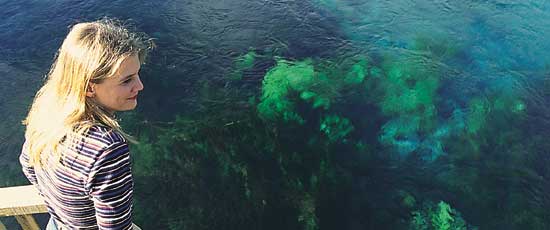

| "> |
Te Waikoropupu (Pupu) SpringsThis is probably GOLDEN BAY'S most famous attraction, and its story and mysteries are still a fascinating one. Looking down at the Takaka Valley from the top of the Takaka Hill you will notice the flat valley floor is separated sharply from the steep hills to the right, and rather less sharply from the Tasman Mountains to its left. Several million years ago earth movements caused the two hilly blocks to rise, while the wedge-shaped area containing today's valley was lowered. The marble rock of the Takaka Hill is famous for its cave system, underground rivers, sinkholes, and associated features. Research has shown that a huge system of flooded chambers exists in the buried marble under the valley. Overlying the marble is a thick layer of sandstones which do not permit the passage of water through them, and act as the 'cap rock' over the waters within the marble. In the Waikoropupu Valley the surface river has eroded down through this cap rock to a point where the underground water, at great pressure, has been able to burst through and emerge as springs.
The water from the main spring is a constant cold temperature of 11.7°C, clear and slightly salty. The flow is not constant; it varies from 7 cubic metres per second during droughts to a maximum of 21 cubic metres per second. The springs system is the largest in New Zealand, and among the 100 largest springs in the world (it ranks about 90th). Where does the water come from? Researchers from early times favoured the Takaka River, as nothing else could supply the enormous volume. This river goes dry during most summers at a point a little below Lindsay's Bridge, near Upper Takaka, where the river flows hard against the Pikikiruna Fault which separates valley from hill slopes. A section of 4.5 kilometres of the riverbed remains dry, the water being taken underground through sinks in the thick gravels. How to prove the connection? This was done several years ago, during a dry spell. Daily, very accurate measurements of the springs’ discharge showed a slow but steady decline in volume. Then a large quantity of water was released from the Cobb Dam into the Takaka River and 10 hours later the discharge rate at the springs rose, to fall again in subsequent days. Other releases of water gave the same upsurge in the springs flow. The business of seawater intrusion is fascinating. For some time it has been known that there are three large freshwater springs in GOLDEN BAY, a few kilometres offshore in depths of 12-14 metres. It is thought that these are part of the marble water-system, and as fresh water flows out, some seawater is drawn into the vents, finding its way to the main vent at Pupu. The area is a Maori taonga (treasure) and a waahi tapu (sacred place), please respect it. Continue to read information about >>>> Pupu Hydro Walkway Golden Bay businesses, get
listed with the Golden Bay Directory, its simple and FREE!
|
||||
Home | User
Contributions | Visitors Guide | Golden
Bay Directory
Contact gbnet | Search
the Net | gbnet Webmail
Advertising and sponsorship opportunities
© 2002 gbnet

